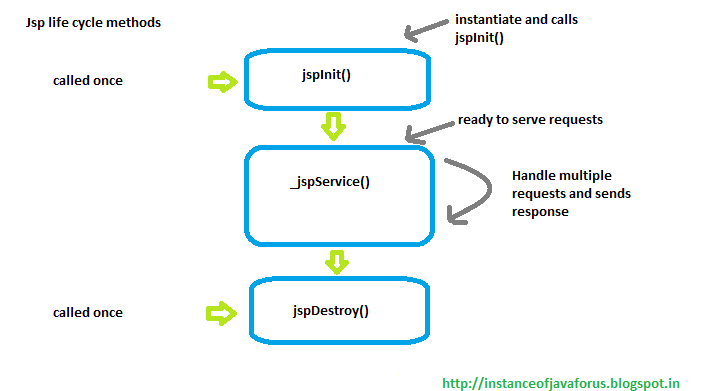Posted by: InstanceOfJava
Posted date:
Dec 7, 2014
/
- jsp engine controls the life cycle of jsp
- Jsp life cycle is described by three life cycle methods and six life cycle phases
Jsp life cycle methods :
- jspInit()
- _jspService()
- jspDestroy()

- Jspinit() method is invoked when JSP page is initialized.
- The _jspService() method corresponds to the body of the jsp page.
- This method is defined automatically by the JSp container and should never be defined y the JSP page author.
Jsp Life cycle Phases:
- Translation phase
- Compilation phase
- Instantiation phase
- initialization phase
- Servicing phase
- Destruction phase
- Jsp engine calls jspInit() method only once during the initialization phase of a jsp.
- similarly during destruction phase jsp engine calls jspDestory() method only once
- For each client request Jsp container calls _jspService() method once.
Jsp Translation phase:
- When client request comes for a jsp for the first time , jsp engine makes a full read of the jsp verifies the syntactical corectness of the jsp elements and converts code into a servlet source code .
- The process of JSP engine translating jsp into servlet nothing but translation phase of JSP.
- Therefore , we say that Jsp development is another style of development asking container to develop the servlet is nothing but JSP developement
- Container generated servlet class is also known as page implementation class.
Jsp Compilation phase:
- The process of jsp engine compiling the page implementation class is nothing but compilation phase of jsp.
- Jsp engine uses JASPER compiler to compile the container generated servlet class source code.
- In the life of the Jsp Translation and compilation happens only once unless jsp source code modified.
Jsp Instantiation phase:
- Container creating the instance of generated servelt class is nothing but instantialtion phase of jsp
- actually now we have a servelt object.
- Servlet engine loads user user defined servlet class file from secondary memory into
primary memory dynamically
class c= class.forName("name");
c.newInstance();
- Servlet engine creates the instance of loaded servlet class.
- Servlet engine uses the following piece of code to load the servlet clas dynamically to instantiate it.
Class c= class.forName("Servlet class name");
c.newInstance();
Initialization:
- Servlet engine creates servletConfig object
- Servlet engine calls the init() method on the servlet instance by supplying servletconfig object
as argument.
- Once init method completely executed servlet is ready to serve the client request.
Servicing :
- Servlet engine creates servlet request and servlet response object based on the web server
provided client information.
- Servlet engine calls service method on the servlet instance by supplying two object reference as arguments
- Once service method is completely executed , client request is served and request-response cycle is complete.
- Within the service method request object is used to capture the user input
- Response object is used to build the dynamic page and hand over the same to the web server
Destruction:
- Destruction phase of servlet represents servlet being removed from use by container




No comments